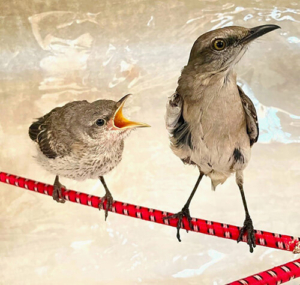To Raise a Mockingbird
By Cori Carlson, Administrative Coordinator

Adult female Northern Mockingbird perches next to nestling Northern Mockingbird.
You have surely heard, if not seen, a Northern Mockingbird in your area. They can be heard serenading at any time of the day and night and can mimic hundreds of noises. This small gray bird with white patches on their wings and long tail feathers, can be found in grasslands, wooded areas, or in your backyard.
In mid-March an orphaned nestling (a baby bird who should still be in the nest being cared for by their mother) was found in West Los Angeles, and was admitted mildly dehydrated, but otherwise healthy.
Typically, we group young animals of the same species and rear them together. Baby birds are most successful when they are raised with others of the same species, learning from each other. However, this young bird came in alone and it was weeks until we received a second Mockingbird. Fortunately, nature had other plans for this special patient.
An adult female Northern Mockingbird was admitted having lost most of her tail feathers after being stuck to a glue trap. While her feathers grew back, our team moved her into the enclosure with the fledgling. Their hope was that she would teach the younger bird species-specific behaviors including how to forage and feed. This blending has been a resounding success.
After a little more than a month in care, the young Northern Mockingbird is now ready to move into an outdoor aviary to acclimate to the temperatures and strengthen their flight muscles before being released into the wild to make beautiful music.
